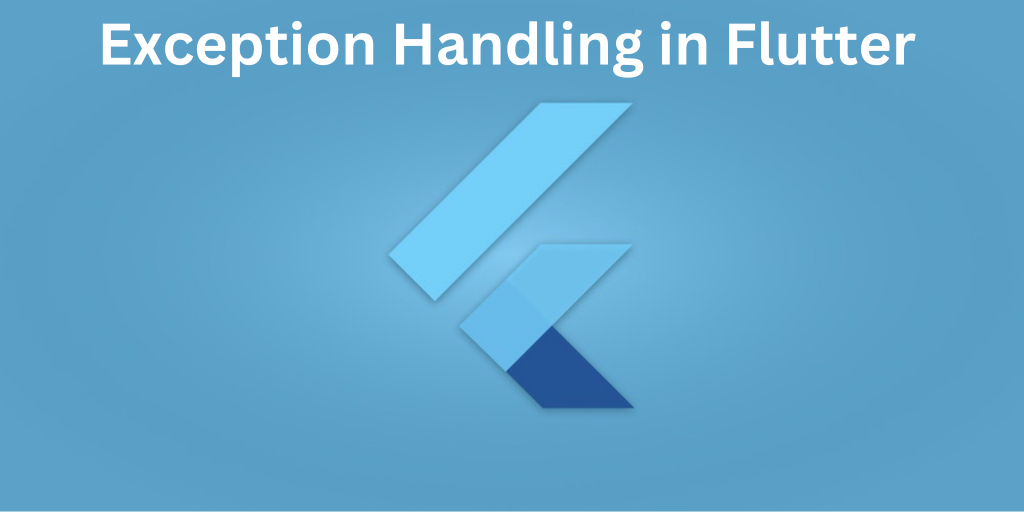In this blog we will learn about Exception Handling in Flutter. An exception is an abnormal condition or event that occurs during the execution of a program and disrupts the normal flow of code.

What is Exception in Flutter
Exceptions are an error which indicates that something unexpected happened in code.
Flutter throw exception when a special and unwanted circumstance occurs, such as trying to divide a number by zero, accessing a null reference, formate exception, network connection failures etc.
The program may be terminated if the exception is not handled properly.
Why need to Exception Handling
- Handling exception is important for creating robust and reliable Flutter application. You can catch exception and log them , and appropriate action to smooth handle error and provide a good experience.
- Exception handling in Flutter is your safety to prevent your app from crashing when unexpected errors occur. It’s all about smoothly managing these errors so that your app keeps running smoothly, ensuring a better user experience.
- It provides a structured way to respond to errors, allowing you to recover gracefully or display user-friendly error messages.
- Exception handling separates the error-handling code from the normal code, making the application more maintainable.
You may also check our Flutter App Development services.
Type of Exception in Flutter
1. Dart Exceptions
a) FormatException: Occurs when you try to parse a value in an incorrect format, like parsing a non- numeric string as an integer.
b) RangeError: Raised when an index or value is out of a valid range, like accessing an index that is out of bounds in a list.
2. Flutter-Specific Exceptions
a) PlatForm Exception: Often encountered when dealing with platform-specific code, like making native platform calls. It may include errors related to device features, such as camera access, permissions, or location etc.
b) Custom Exceptions
In flutter you can create your own exception by defining new exception classes that extend existing Dart exception classes, such as ‘Exception‘ or ‘Error‘. It is helpful to can help you categorize and handle specific errors in your application more effectively.
4. Async/Await Exceptions
Exceptions that can occur when we are working with asynchronous, like Future and async/await. These might include errors related to network requests, database operations, or timeouts etc.
When we dealing with network requests or asynchronous operations, you often use async/await and handle exceptions with try-catch blocks. Dart’s Future and async/await provide a structured way to handle asynchronous errors.
Difference between error and exception in Flutter
Errors:
- When an error occurs, it usually results in the termination of your program or application. Errors are not intended to be caught and handled by your code because they typically indicate failure beyond the control of your application.
- Errors are typically considered unrecoverable issues in your program. They represent severe, unexpected problems that can’t be handled deftly. Examples of errors include running out of memory, stack overflow etc.
- Dart doesn’t provide a mechanism to catch and handle errors with a try-catch blocks.
- Common Errors in Flutter:
a) StackOverflowError: Occurs when the call stack becomes full.
b) OutOfMemoryError: Happens when the system runs out of memory.
Exception:
- Exceptions are intended to represent recoverable errors or exceptional conditions in your code. They indicate issues that can be handled gracefully and don’t necessarily lead to the termination of the program.
- You can catch the exception with help of try-catch blocks. Try-Catch blocks useful to catch and handle exceptions in your code. This allows you to respond to exceptional conditions, provide error messages and keep your application running smoothly.
- Represents unexpected but recoverable issues. They are meant to be caught and handled to prevent app crashes and provide better error messages to users.
- Common Exception in Flutter:
a) FormatException: Occurs when you try to convert a string into a numeric type (int or double), and the string is not in the expected format.
b) RangeError: Thrown when you try to access an index or value that is out of a valid range, such as trying to access an index that is out of bounds in a list.
c) TimeoutException: This exception occurs when an operation takes longer to complete than a specified time limit, such as in network requests or asynchronous operations.
How to Handle Exception?
We can handle exceptions with multiple ways which is mentioned below.
1.Using Try and Catch.
We can handle the exception with help of Try/Catch block.
a) Try:
A try block is the block of code in which exception can occur. In try block you can put those code on in which exception can occur. during the execution of program.
b) Catch:
Catch block is use to catch and handle any exceptions thrown in the try block. To catch specify exception with the help of catch keyword.
c) Finally:
Finally block is optional and is always executed whether any exception is occur or not. Finally block is executed after the try/catch block .
|
1 2 3 4 5 6 7 8 9 10 11 12 13 14 15 16 17 |
Future<void> youMethod() async { var url = Uri.parse('https://jsonplaceholder.typicode.com/posts'); try { final response = await http.get(url).timeout(Duration(seconds: 5)); if (response.statusCode == 200) { print("You response data is here==->${response.body}"); } else { print("Not Getting success"); } }catch (error, _) { print(error.toString()); }finally { print('API call completed.'); } } |
Conclusion
Exception handling in Flutter is necessary to make your app better, user-friendly, and easier to manage. Exception Handling is an essential component of building a reliable and flexible Flutter application.
For more knowledge related to this topic you can check here.
In this blog we have discussed about Exception Handling in Flutter.
You can also check other blogs from here for more knowledge.

Be the first to comment.